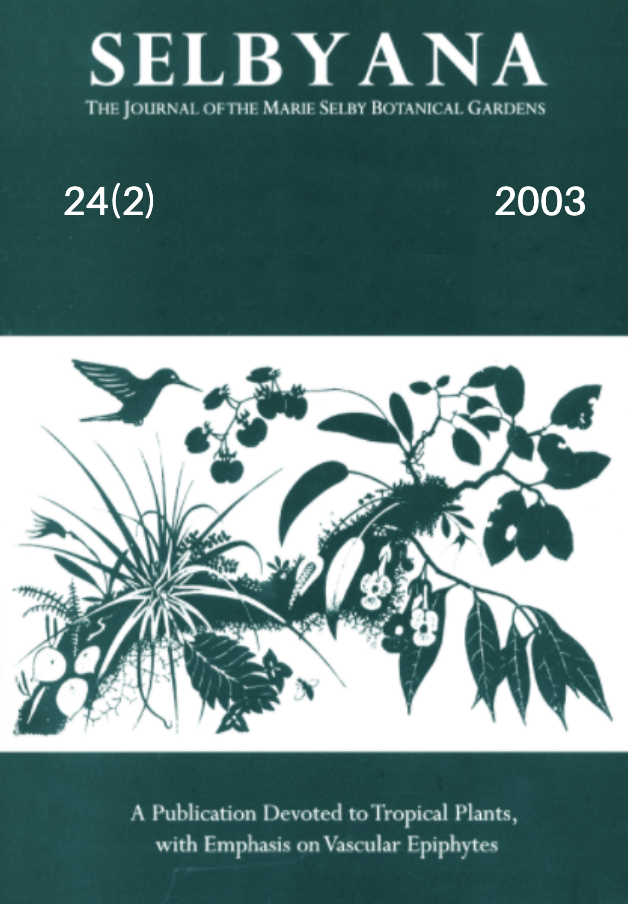Abstract
The present work aims to extend the knowledge of the genus Vriesea Lindley, contributing data on the foliar anatomy of five species: Vriesea bituminosa Wawra, V. longiscapa Ule, V. triligulata Mez, V. gigantea Gaudich., and V. fosteriana L. B. Sm. Transverse and longitudinal cuts were made manually in fully expanded leaves. The usual histochemical tests were performed. Features typical to the Bromeliaceae were peltate trichomes, single layered epidermis, stomata located only on the abaxial surface of the leaves, a hypodermis with mechanical and water-storing functions, and collateral vascular bundles. Observed differences among the species were number of trichomes in both lamina and sheath, number of cells on the trichome shield, and number of layers of the aquiferous hypodermis. Many of the observed characteristics confirm the xerophytic nature of the leaves. The anatomical organization of the leaves in the studied Bromeliaceae could be related both to environmental pressures as well as to phylogenetic relationships. O presente trabalho tem como objetivo ampliar o conhecimento acerca do gênero Vriesea Lindley fornecendo dados sobre a anatomia foliar de cinco espécies: Vriesea bituminosa Wawra, V. longiscapa Ule, V. triligulata Mez, V. gigantea Gaudich. e V. fosteriana L. B. Sm. O material botânico foi cortado a mão livre. Testes histoquímicos usuais foram realizados. Os resultados mostraram que as espécies exibem as características típicas da família: folhas hipoestomáticas, epiderme simples dotada de tricomas peltados multicelulares, hipoderme com funções mecânica e de reserva de água, tecido clorofiliano diferenciado em paliçádico e esponjoso do tipo braciforme e feixes vasculares colaterais. Foram notadas diferenças entre as especies com relação à quantidade de tricomas ao longo da folha; número de células que compõem o escudo dos tricomas e número de carnadas da hipoderme aquífera. As características observadas confirmam a natureza xerofítica das folhas. A organizaçao anatômica das folhas das Bromeliaceae estudadas pode ser urna resposta a pressões ambientais assim como refletir relações filogenéticas.
Open Access and Copyright Notice
Selbyana is committed to real and immediate open access for academic work. All of Selbyana's articles and reviews are free to access immediately upon publication. There are no author charges (APCs) prior to publication, and no charges for readers to download articles and reviews for their own scholarly use. To facilitate this, Selbyana depends on the financial backing of the Marie Selby Botanical Gardens, the hard work and dedication of its editorial team and advisory board, and the continuing support of its network of peer reviewers and partner institutions.
Authors are free to choose which open license they would like to use for their work. Our default license is the Creative Commons Attribution-NonCommercial 4.0 (CC BY-NC 4.0). While Selbyana’s articles can be copied by anyone for noncommercial purposes if proper credit is given, all materials are published under an open-access license with authors retaining full and permanent ownership of their work. The author grants Selbyana a perpetual, non-exclusive right to publish the work and to include it in other aggregations and indexes to achieve broader impact and visibility.
Authors are responsible for and required to ascertain that they are in possession of image rights for any and all photographs, illustrations, and figures included in their work or to obtain publication or reproduction rights from the rights holders. Contents of the journal will be registered with the Directory of Open Access Journals and similar repositories. Authors are encouraged to store their work elsewhere, for instance in institutional repositories or personal websites, including commercial sites such as academia.edu, to increase circulation (see The Effects of Open Access).
